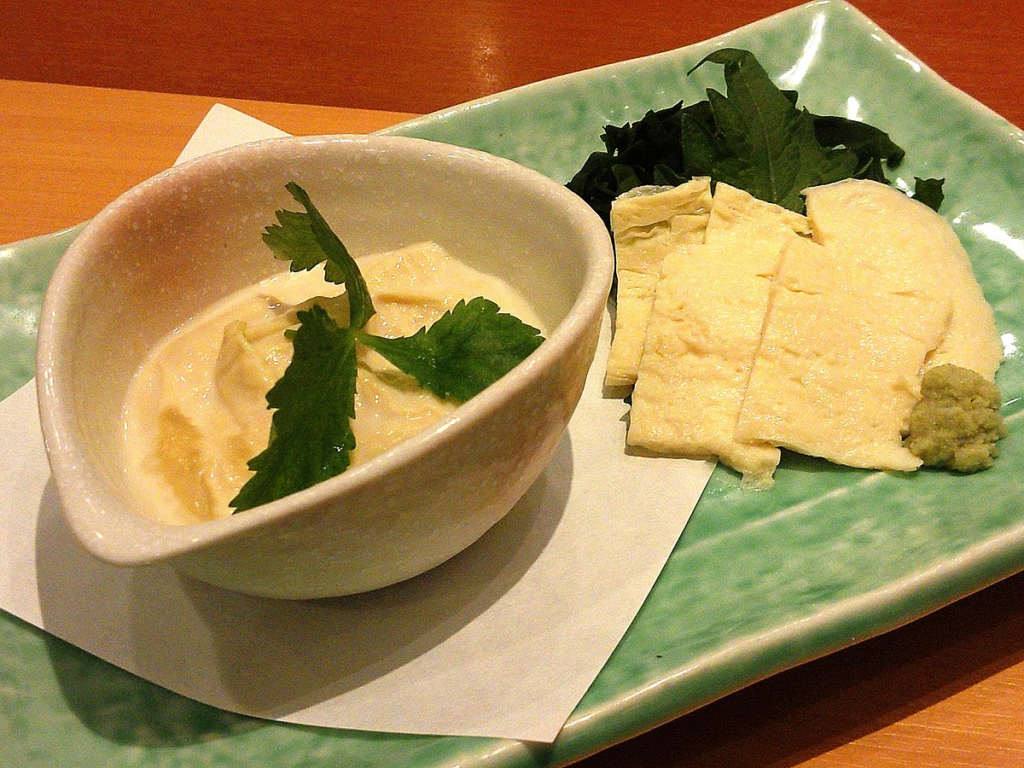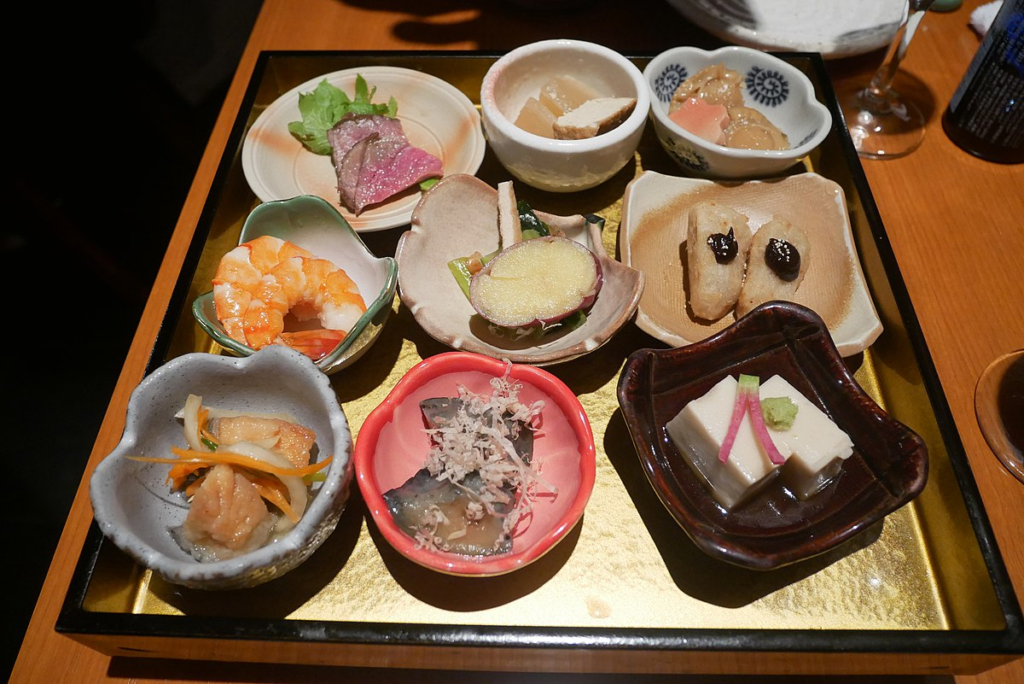Kyoto is renowned not only for its historic temples and serene gardens but also for its distinctive and refined cuisine. This guide explores Kyoto’s must-try local dishes and highlights the best spots to savor these iconic specialties. Whether you’re a foodie searching for hidden gems or a curious traveler looking to immerse yourself in Kyoto’s unique food scene, this list will satisfy your cravings and introduce you to the essence of Kyoto’s culinary heritage.
Yuba: Kyoto’s Tofu Skin Delicacy

Yuba, or tofu skin, is a traditional Kyoto delicacy made by simmering soy milk and carefully lifting the delicate skin that forms on its surface. Celebrated for its smooth texture and rich flavor, yuba holds a special place in Kyoto’s food culture.
Kyoto chefs have created a variety of dishes using yuba, ranging from rice bowls and soups to innovative desserts, ensuring there’s a way for everyone to experience this unique ingredient.
Where to try Yuba:
Kyo Yuba Mitakyu Kiyomizu
Located near Kyoto station, this eatery has been specializing in yuba dishes for a century. Here, you can explore a variety of tofu skin preparations, each crafted in unique ways, and indulge in this exquisite Kyoto delicacy.
https://mitakyu.com/ (Japanese only)
Yuba Higashiyamayuuzu
Tucked in Gion’s charming backstreets, this haven offers authentic yuba dishes made with fresh, seasonal ingredients. A blend of classic and modern techniques creates a thrilling culinary experience, with seating options ranging from lively counters to private tatami rooms.
https://higashiyamayuuzu.com/ (Japanese only)
Chasoba: Kyoto’s Refreshing Green Tea Noodles

Chasoba (茶そば) is a unique variation of traditional soba noodles that incorporates matcha (green tea) into the dough, giving it a distinctive green color and a refreshing, aromatic flavor. The addition of matcha provides a subtle yet delightful tea fragrance that complements the earthy taste of the soba. Chasoba is known for its smooth texture, offering a satisfying bite and a smooth, silky finish when slurped.
In Kyoto, the birthplace of matcha, you’ll find numerous soba shops serving this special noodle dish.
Where to try Chasoba:
eX cafe Kyoto Arashiyama
eX cafe is located in the heart of Arashiyama, making it a perfect location to try chasoba on your way to check out the bamboo path. In addition to their chasoba, they offer a range of dishes such as matcha sweets, toasted mochi, and adorable kitty bread.
Check out eX cafe Kyoto Arashiyama on Facebook.
Ujiso Cocoro
This eatery is located in Uji city, a short trip from the center of Kyoto. This restaurant serves delicious chasoba sets and many other delectable dishes.
https://www.ujiso-cocoro.com/ (Japanese only)
Nama-Fu: Kyoto’s Versatile Wheat Gluten Delicacy

Nama-fu (生麩) is a traditional Kyoto specialty made from wheat flour and glutinous rice flour. Its origins date back to the Kamakura period when it was first used as a key ingredient in shojin ryori, the vegetarian cuisine of Buddhist monks. Nama-fu is prepared by forming wheat gluten, resulting in a chewy, mochi-like texture that is both unique and satisfying.
Not only is nama-fu delicious, but it’s also highly nutritious. It’s low in calories and rich in plant-based protein, making it a great choice for those seeking a healthy, balanced diet. In Kyoto, nama-fu is served in various forms, from savory to sweet. A popular preparation is fu dengaku, where the wheat gluten is skewered, grilled, and coated with miso sauce. For dessert, nama-fu manju, a sweet filled with red bean paste, is a beloved Kyoto treat that highlights its chewy texture and delicate flavor.
Where to try Nama-Fu:
Fufusarouho
This long-established nama-fu store is in the heart of Nishiki market in Kyoto. Try their fu dengaku or buy some vacuum-packed wheat gluten as a souvenir!
Fuka Honten
Fuka has refined namafu for over a century and have made a name for themselves as a supplier to the Kyoto Imperial Palace. Fuka is also the birthplace of namafu manju.
Yudofu: Kyoto’s Warm Tofu Hot Pot

Yudofu (湯豆腐) is a warm and comforting dish that is especially popular in Kyoto during the colder months. Made with soft tofu, the dish is served in a light, simple broth, often alongside vegetables like green onions and mushrooms. The tofu is heated in the hot broth, making it tender and silky, and the dish is often enjoyed with a dipping sauce such as soy sauce or sesame sauce for added flavor.
What makes yudofu particularly special is not only its gentle and warming qualities but also its health benefits. Tofu, made from soybeans, is low in calories but packed with protein and nutrients, making it a great choice for a light yet nutritious meal.
Where to try Yudofu:
Okabeya
Located in a kyomachiya (a traditional townhouse) on the sidestreets near Kiyomizu-dera Temple, this restaurant offers a number of tofu dishes, including yudofu and yuba.
https://www.okabeya.com/lang/en.html
Yudofu Sagano
This restaurant features tofu dishes such as yudofu with views of a tranquil Japanese garden. It’s about a 10 minute walk from Sagano-Arashiyama station on the JR Sagano line.
https://kyoto-sagano.jp/ (Japanese only)
Kyo no Obanzai: Kyoto’s Colorful Seasonal Feast

Kyo no Obanzai (京のおばんざい) refers to a style of traditional home-cooked food that originated in Kyoto. The term “obanzai” is derived from the word “ban,” which refers to everyday or common things, such as the humble, everyday dishes served in a typical Kyoto household. It’s a reflection of the town’s traditional food culture, where simple, seasonal ingredients were prepared in ways that highlighted their natural flavors.
The dishes are often made with Kyoto’s renowned seasonal vegetables, known as kyo-yasai (京野菜), such as turnips, cabbage, and bamboo shoots. These ingredients are stewed or simmered to bring out their delicate, subtle flavors. The focus of obanzai meals is on simple, comforting dishes that are nourishing and easy to prepare. It is said that the beauty of Kyoto’s vegetables truly shines when they are prepared in this simple, rustic way.
Where to try Kyo no Obanzai:
Ouchigohan Nakashimaya
Experience the charm of Kyoto’s seasonal flavors at this cozy Shijo-Karasuma eatery, blending traditional home-cooked dishes with a modern twist. Featuring fresh, locally sourced vegetables, curated sake pairings, and a nostalgic yet stylish ambiance, it’s the perfect spot to savor Kyoto’s culinary and cultural essence.
https://ouchigohan-nakashimaya.com/en_us
Kyomachiya Obanzai Kohaku
Enjoy seasonal Kyo no obanzai featuring fresh Kyoto vegetables in a renovated 100-year-old townhouse. The stylish, modern interior offers counter and table seating on the first floor, with tatami rooms for group dining on the second.
Kyomachi Obanzai Kohaku’s Website
Kyoto Ramen: A Local Twist on Japan’s Favorite Noodle Dish

Kyoto ramen is a distinctive regional style of ramen that has gained popularity not just in Kyoto, but also in the neighboring areas like Shiga Prefecture.
The typical Kyoto ramen broth is soy sauce-based and rich in flavor, but you’ll find a variety of styles depending on the shop.
Dive deeper into the world of Kyoto ramen and discover where to savor the finest bowls in our Kyoto ramen article.
Savor the Flavors of Kyoto’s Local Food
Kyoto offers a culinary adventure unlike any other city in Japan. While this list will help get you started, there are many other flavors and wonderful restaurants to explore. Whether you’re exploring historic temples or strolling through scenic streets, don’t forget to stop and savor the unique flavors that Kyoto is famous for.







